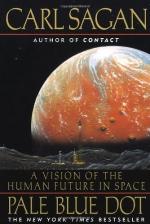
|
| Name: _________________________ | Period: ___________________ |
This test consists of 5 short answer questions, 10 short essay questions, and 1 (of 3) essay topics.
Short Answer Questions
1. What happens to the number of asteroids and comets in the solar system as time goes on?
2. What did Steven Hawking worry about with regard to black holes?
3. Sagan suggests that humans could live and thrive around what unusual type of star?
4. What type of asteroids does Sagan suggest that men might be able to live inside of?
5. How old are the terrain features generated by Venus' volcanoes?
Short Essay Questions
1. What does Sagan believe black holes have to offer?
2. What profit motivations exist in a manned mission to Mars?
3. How well can an asteroid's path be calculated?
4. What does Sagan want to see on Mars?
5. What promising signs does Mars have for being host to life?
6. What does Sagan conclude about the morality of terraforming and planetary colonization?
7. What is unusual about the ring systems of the planets in our solar system?
8. How is Venus similar to Earth?
9. How could planetary tides pull a small planet apart?
10. What does Sagan think were the major upsides of the Apollo missions?
Essay Topics
Write an essay for ONE of the following topics:
Essay Topic 1
Terraforming is the process of modifying and entire planet to make it more hospitable for human life.
1) Describe the processes of terraforming that Sagan outlines for Mars and the moon Titan.
2) Discuss the moral aspects of the effort of terraforming, and summarize Sagan's views on the issue.
3) Describe, according to information and arguments from the book, some of the benefits that the human species as a whole would reap through the wholesale terraforming of another planet.
Essay Topic 2
Each of the Voyager craft were fitted with golden phonograph records containing carefully selected information to be sent along with the probes into deep space.
1) Discuss the purpose of the Voyager records.
2) Explain the design of the Voyager records, why they are expected to endure without losing data, and how an alien intelligence would be expected to decode them.
3) Discuss the information contained on the records and why it was selected.
Essay Topic 3
Titan is the largest moon of Saturn and the most Earth-like of all of the moons in the solar system, making it a good candidate for finding extraterrestrial life.
1) Describe the characteristics of the moon Titan, including a discussion of its atmosphere and hydrocarbon lakes.
2) Assess the specific characteristics of the moon that make it suitable for life.
3) Discuss Sagan's personal involvement in the study of Titan, its importance to him, and why he believes the moon warrants further study.
|
This section contains 706 words (approx. 3 pages at 300 words per page) |

|




